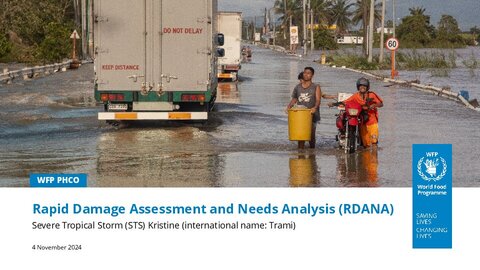
On 24 October, severe tropical storm (STS) Kristine (international name: Trami) triggered widespread flooding and landslides in Luzon, Visayas, and parts of Mindanao, with the Bicol Region among the most severely impacted areas. This report compiles the findings of the rapid damage assessment and needs analysis (RDANA) conducted by WFP in three hardest-hit Bicol provinces from 27 to 29 October.
The main findings of the RDANA are:
- The Bicol Region is facing significant food security challenges. Food and water remain top priority needs for the affected populations, especially those staying in evacuation centres and communities where access to a regular supply of goods and water was cut off.
- In Camarines Sur, many families depend on the Government’s family food packs (FFPs), private individuals, and non-government organizations (NGOs). The immediate needs identified include cash, food, water, and other assistance, especially for single-women-headed households, persons with disabilities, and the elderly. Local markets started reopening, but price increases in goods were reported.
- The Province of Albay was placed under a state of calamity due to STS Kristine. Distribution of FFPs is ongoing, but additional resources are essential to meet the needs. Several areas are still inaccessible, which poses a significant challenge in distribution.
- In the Province of Catanduanes, food security remained a challenge, especially for families who remained in the evacuation centres. Agriculture was reported by the Provincial Disaster Risk Reduction and Management Office (PDRRMO) to have been severely damaged.
- To date, the national and local governments and various NGOs have been providing emergency assistance to the affected populations in response to the devastating effects of the storm. DSWD Region V office has already distributed FFPs, non-food items, and financial assistance to the affected population worth US$3.1 million (PHP 181,326,750) as of 30 October.
- The most notable gaps in the emergency response would be the lack of financial resources for the affected population to support livelihoods and deal with food price increases.
